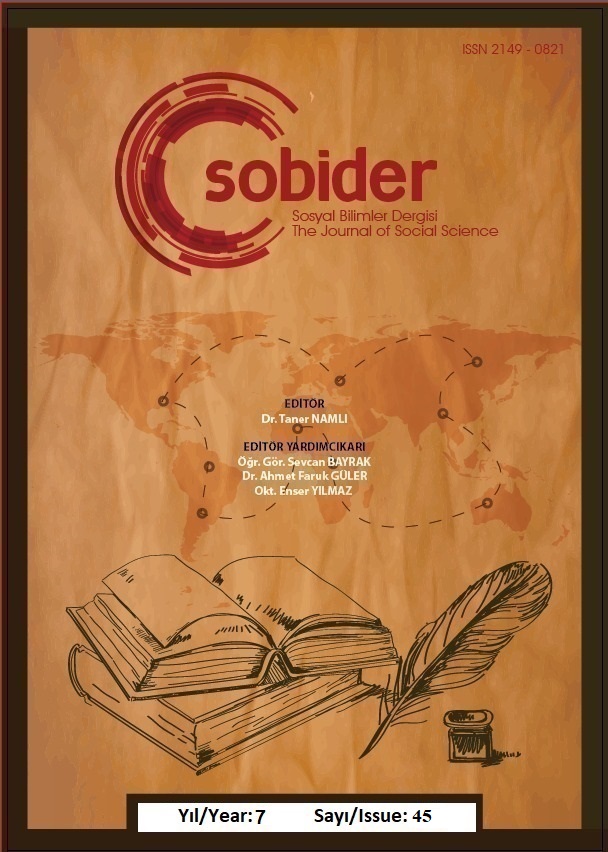Author :
Abstract
Bu çalışmada spor bilimleri fakültesi 4.sınıf öğrencilerinin aktif veya pasif olarak katıldıkları serbest zaman etkinliklerinden tatmin olma düzeyleri belirlenecektir. Böylelikle tatmin olma düzeylerinin bazı değişkenlere göre farklılık gösterip göstermediği de incelenecektir. Araştırmayı Fırat Üniversitesi spor bilimleri fakültesinde öğrenim gören toplam 233 öğrenci grubu oluşturmaktadır ve bu öğrenciler tesadüfi örnekleme yöntemiyle seçilmiştir. Araştırmada veri toplamak amacıyla kişisel bilgi formu ve 39 soru maddesinden oluşan “Serbest Zaman Tatmin” ölçeği kullanılmıştır. Araştırmada elde edilen veriler SPSS 22. (Statistical Package for Social Sciences) programı kullanılarak analiz edilmiştir. Anlamlılık düzeyi p<0,05 olarak kabul edilmiştir. Sonuç olarak öğrencilerin aylık gelirleri, katılımcıların serbest zaman etkinliklerine katılım sıklığı, üniversitenin sağladığı rekreatif imkan yeterliliği ile serbest zaman tatmin ölçek alt boyutları arasında anlamlı farklılıklar tespit edilmiştir. Diğer yandan, cinsiyet, yaş, bölüm, sahip olduğu serbest zaman süresi (haftalık-saat) ve serbest zaman etkinliklerine kimlerle katılım gerçekleştirildiği değişkenleri ile serbest zaman tatmin ölçek alt boyutları arasında anlamlı farklılıklara rastlanmamıştır.
Keywords
Abstract
In this study, the levels of satisfaction of the 4th grade students of the faculty of sports sciences from the leisure time activities they actively or passively participate in will be determined. Thus, it will be examined whether the levels of satisfaction differ according to some variables. The study consists of 233 student groups studying at the Faculty of Sports Sciences of Fırat University and these students were selected by random sampling method. In the research, "Free Time Satisfaction" scale, consisting of a personal information form and 39 question items, was used to collect data. The data obtained in the study were analyzed using the SPSS 22. (Statistical Package for Social Sciences) program. Significance level was accepted as p <0.05. As a result, significant differences were found between the monthly income of the students, the frequency of participation of the participants in the leisure activities, the capacity of recreational opportunities provided by the university and the free time satisfaction sub-dimensions. On the other hand, no significant differences were found between the variables of gender, age, department, free time duration (weekly-hour), and who participated in free time activities and the free time satisfaction sub-dimensions.
Keywords
- Aydoğan, F. (2000). Medya ve Serbest Zaman. Om Yayınevi: İstanbul
- Seyidoğlu H. Bilimsel Araştırma ve Yazma El Kitabı. İstanbul: Güzem Can Yayınları; 2009, s.
- Altunışık R, Coşkun R, Bayraktaroğlu S, Yıldırım E. Sosyal Bilimlerde Araştırma Yöntemleri. 3. basım. Sakarya: Sakarya Kitabevi; 2005, s: 120.
- Ural A. Kılıç İ. Bilimsel Araştırma Süreci ve Spss İle Veri Analizi. Ankara: Detay Yayıncılık; 2006, s: 45.
- Beard JG. Ragheb MG. Measuring Leisure Satisfaction. Journal Of Leisure Research. 1980; 12 (1): 20–33.
- Karlı Ü. Polat E. Yılmaz B. Koçak S. Serbest Zaman Tatmin Ölçeği’ nin (SZTÖ-Uzun Versiyon) Geçerlilik ve Güvenilirlik Çalışması. Hacettepe Spor Bilimleri Dergisi. 2008; 19 (2): 80-91.
- Lu L, Hu CH. (2005). Personality, leisure experiences and happiness. Journal of Happiness Studies, 6, 325- 342.
- Siegenthaller KL, O’Dell I. (2000). Leisure attitude, leisure satisfaction and perceived freedom in leisure within family dyads. Leisure Sciences, 22, 281-295.
- DiBona L. (2000). What are the benefits of leisure? An exploration using the leisure satisfaction scale. British Journal of Occupational Therapy, 63 (2), 50-58.
- Berg E, Trost M, Schneider IE, Allison MT. (2001). Dyadic exploration of the relationship of leisure satisfaction, leisure time, and gender to relationship satisfaction. Leisure Sciences, 23, 35–46.
- Griffin J, McKenna K. (1998). Influences on leisure and life satisfaction of elderly people. Physical & Occupational Therapy in Geriatrics, 15 (4), 1-16.
- Boley BJ. (2001). Life Satisfaction, Leisure Satisfaction, and Leisure Participation Among Publicly Housed Older Adults. Unpublished Doctoral Dissertation. Capella University. Minneapolis, MN.
- Lapa TY, Ardahan F (2009), Akdeniz Üniversitesi Öğrencilerinin Serbest Zaman Etkinliklerine Katılım Nedenleri ve Değerlendirme Biçimleri, Hacettepe J. of Sport Sciences, 20 (4), 132–144
- Misra R, McKean M. (2000). College students academic stress and its relation to their anxiety, time management, and leisure satisfaction. American Journal of Health Studies, 16 (1), 41-51.
- Vong Tze N. (2005). Leisure satisfaction and quality of life in Macao, China. Leisure Studies, 24 (2), 195-207.
- Kabanoff B. (1982). Occupational and sex differences in leisure needs and leisure satisfaction. Journal of Occupational Behavior, 3, 233-245.
- Ardahan F, Lapa YT (2010), Üniversite Öğrencilerinin Serbest Zaman Tatmin Düzeylerinin Cinsiyete ve Gelire Göre İncelenmesi, Hacettepe J. of Sport Sciences, 21 (4), 129–136
- Russell RV. (1987). The importance of recreation satisfaction and activity participation to the life satisfaction of age-segregated retirees. Journal of Leisure Research, 19 (4), 273283.
- Borke J, Dedding M, Lausten M. (2009). Time and Money: A simultaneous analysis of men’s and women’s domain satisfactions. J Happiness Stud, 10, 113–131.
- Mancini JA. (1978). Leisure satisfaction and psychologic well-being in old age: effects of health and income. Journal of the American Geriatrics Society, 26 (12), 550-552.
- Beard JG, Ragheb MG. (1980). Measuring leisure satisfaction. Journal of Leisure Research, 12 (1), 20-33.
- Müderrisoğlu H, Uzun S. (2004). Abant İzzet Baysal Üniversitesi orman fakültesi öğrencilerinin rekreasyonel eğilimleri. Süleyman Demirel Üniversitesi Orman Fakültesi Dergisi, 2, 108-121.
- Emrah S. Marmara Üniversitesi Sağlık Bilimleri Enstitüsü Yüksek Lisans Tezi.2016, üniversite öğrencilerinin katıldıkları serbest zaman etkinliklerinden tatmin olma ve algılanan özgürlük düzeylerinin incelenmesi çalışması. (Danışman Yrd.Doç.Dr Serap Mungay Ay).





